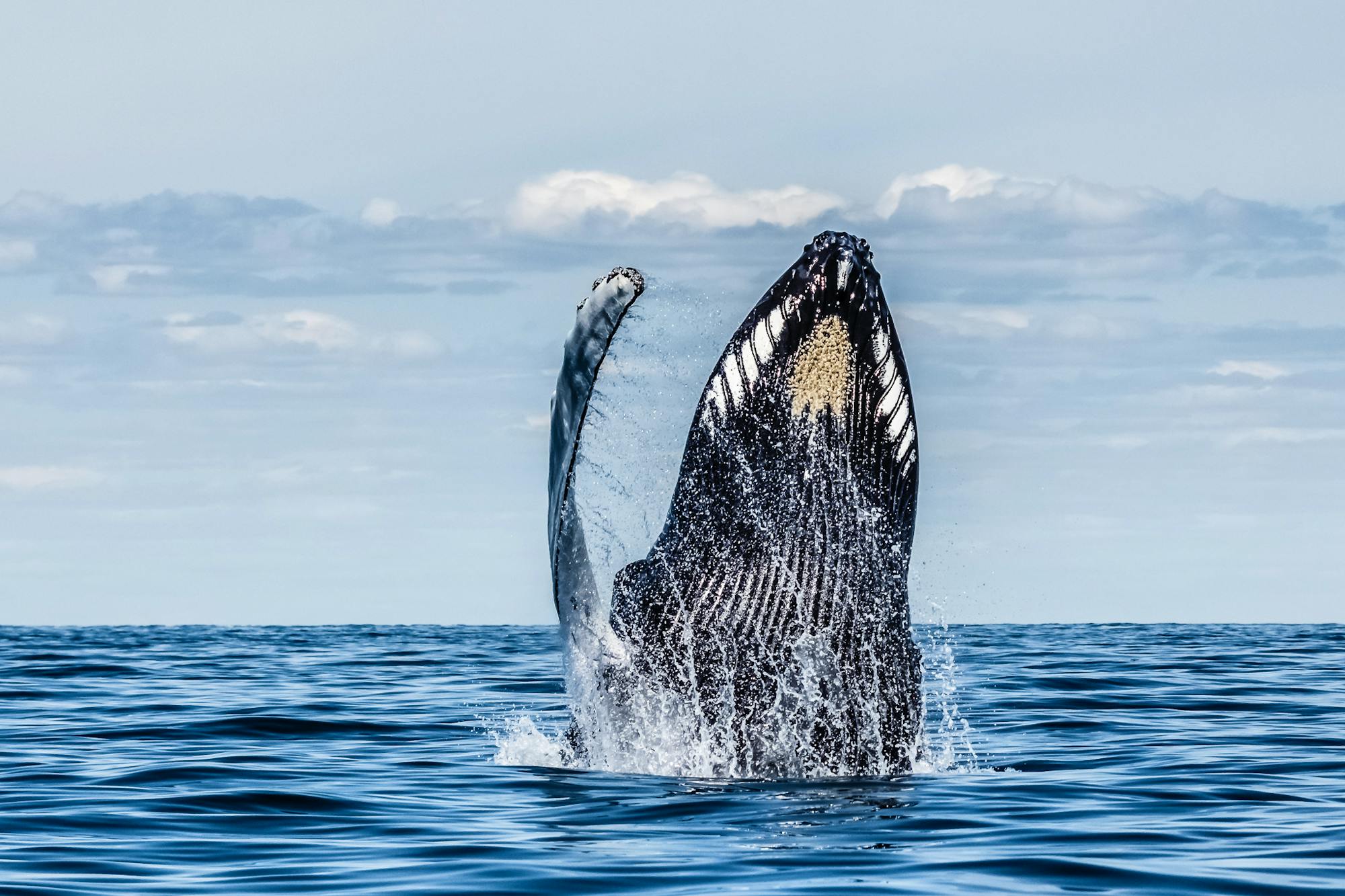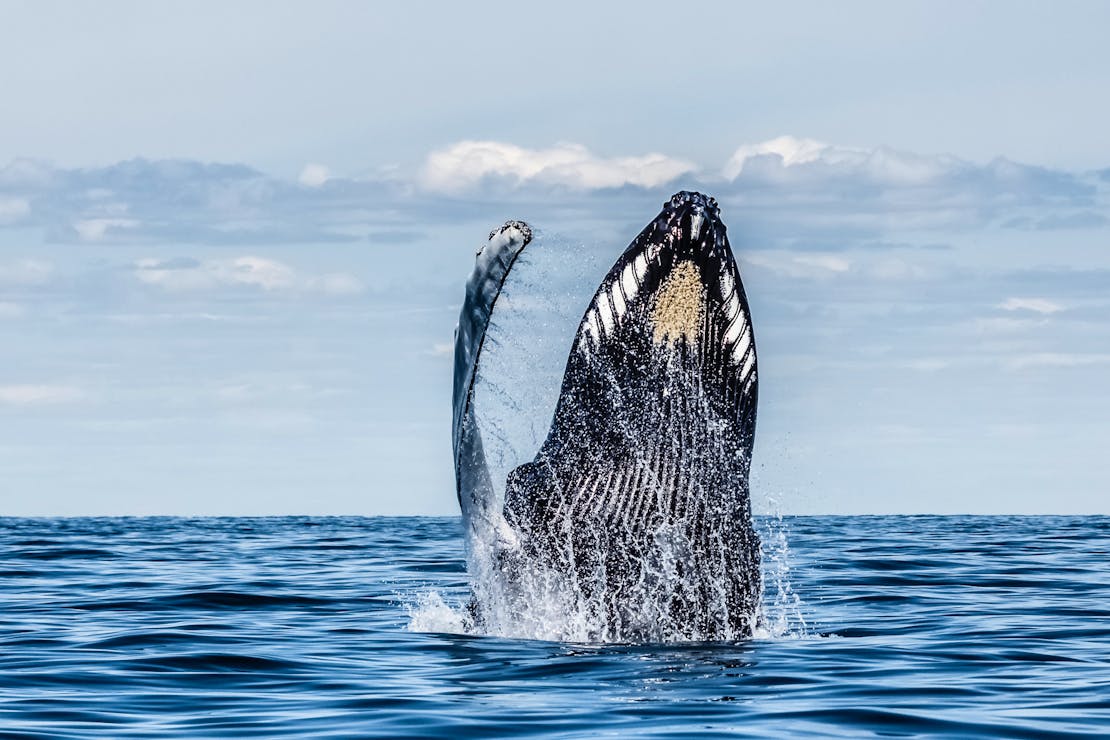Whales don’t get enough credit for the work they do to keep our planet livable. If you’ve ever seen a whale breach the ocean’s surface, you understand why these striking cetaceans are described in terms of majesty and grace, inspiring awe in us land-dwelling creatures lucky enough to catch a glimpse of their grandeur. But beyond the recreational and economic benefits of whale-watching, whales perform crucial functions in the ocean ecosystem that add priceless benefits to the terrestrial ecosystems we require to survive. Scientists have called large whales “ecosystem engineers.” Research has shown that whales cycle nutrients in the ocean, help create the oxygen we breathe, and play a critical role in mitigating greenhouse gases. Not only breathtaking, whales are also breath-giving.
Impacts of climate change on oceans
Science tells us that human actions have changed our planetary climate and that drastic changes for people, wildlife, weather, and ecosystems are already occurring. A new Special Report from the Intergovernmental Panel on Climate Change (IPCC) brings much-needed attention to the plight of our oceans and cryosphere (the places where water is frozen into ice or snow) and warns that reductions in greenhouse gas emissions and adaption measures are urgently required to respond to the climate catastrophe and to avoid even more disastrous consequences.
Authored by over 100 scientists from 36 different countries, the report spells out many of the direct impacts of climate change on our oceans and cryosphere. It warns that oceans are warming and becoming more acidic, leading to declines in marine life, and posing risks to communities highly dependent on seafood. As sea levels rise, coastal communities are faced with more frequent and severe weather events with deadly consequences. The rapid melting of glaciers, snow, ice, and permafrost will increase landslides, avalanches, rockfalls, and floods. And humans are not alone in paying the price of a warming climate. The IPCC report also found “severe impacts on biodiversity, structure and function of coastal ecosystems are projected to be higher for elevated temperatures under high compared to low emissions scenarios in the 21st century and beyond.” In other words, reducing emissions is critical to the health of our planet and all the species it supports.
Whales reduce greenhouse gas
But deep within the ocean itself lies a solution. Marine biologists have discovered that whales play a significant role in capturing and storing carbon, a greenhouse gas, from the atmosphere. According to the International Monetary Fund (IMF), whales, often long-lived, accumulate an impressive amount of carbon in their bodies. When a great whale dies and sinks to the bottom of the ocean, it can sequester over 33 tons of CO2, removing it from the atmosphere for hundreds of years. To put this in perspective, a single tree may remove up to only 48 pounds of CO2 each year. A whale that lives out a 60-year lifespan contributes two million dollars’ worth of ecosystem services to the planet.
Scientists have also discovered that whales increase ocean phytoplankton, microscopic plants that consume CO2 and create oxygen. Whale waste fertilizes phytoplankton growth by bringing nutrients the ocean surface. Whale migration also helps to spread nutrients far and wide within the ocean. Small but mighty, phytoplankton are responsible for capturing 40 percent of all CO2 produced and are responsible for at least 50 percent of all oxygen on earth. In these ways, whales are playing an enormous role in reducing greenhouse gas emissions and conserving them would directly address the climate crisis we now face. The IMF estimates that “even a 1 percent increase in phytoplankton activity thanks to whale activity would capture hundreds of millions of tons of additional CO2 a year, equivalent to the sudden appearance of 2 billion mature trees.”
Whale populations not rebounding
Unfortunately, whale populations have not rebounded to levels that existed before overexploitation by the whaling industry up through the 20th century. The North Atlantic right whale, iconic target of the Yankee whaling industry, numbers no more than 400 surviving animals. Overall, biologists estimate that global whale populations are now down to less than one-fourth of what they were before commercial whaling. To date, the main threats to whales are human-caused activities, including ship strikes and entanglement in fishing gear. Emerging threats include increased offshore energy development and noise pollution that impairs hearing and communication in these hearing-dependent species.
North Atlantic right whales pushed towards extinction
The North Atlantic right whale is in a particularly perilous situation, with fewer than 95 breeding-age females remaining. Ship strikes continue to kill right whales. More than 85 percent of right whales bear the scars of entanglement from fishing gear, such as the buoy lines used in lobster and crab traps and pots. Entanglement in fishing gear can drown an animal (especially calves and juveniles) quickly or result in a slow and agonizing death from infection and starvation. Even whales that survive entanglements don’t get off scot-free. The energetic burden of dragging around heavy gear while potentially being unable to feed properly with lines around or through their mouths has caused the calving rate to drop from one calf every 3-4 years to one only every 10 years. In the last three years alone, we’ve seen at least 30 deaths from ship strikes and entanglements, although whales that die from entanglement often sink to the bottom of the ocean undetected as their emaciated bodies do not have enough fat stores to float. In that same time, we’ve only seen 12 calves born. The math is simple, but terrible – a species that loses more individuals than it produces is on the path to extinction.
We are also losing out on the valuable ecosystem services right whales could provide, especially if we can reverse course and help the population grow. Scientists aren’t sure how long a right whale’s natural lifespan is, because human activities kill right whales before they have the chance to die of old age, but estimate it is at least seventy years. But the average right whale is killed by age 40. By killing right whales through ship strikes and entanglements, we are not only pushing the species towards extinction but losing out on decades worth of their service to our blue planet.
How you can help whales
In the time you’ve taken to read this post, you’ve likely taken up to 100 breaths. Thank a whale by urging the National Marine Fisheries Service, the agency responsible for ensuring the North Atlantic right whale does not go extinct on our watch, to proceed immediately with developing and implementing additional regulatory protections for the species. The time to take conservation seriously is now. The whales depend on it, and our future on the planet might too.
Your support ensures our expert team of scientists, lawyers, advocates and activists have the resources needed to demand action and protection for wildlife across the nation.
Donate Today!













Follow Defenders of Wildlife
facebook bluesky twitter instagram youtube tiktok threads linkedin